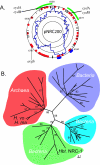Post-genomics of the model haloarchaeon Halobacterium sp. NRC-1
- PMID: 16542428
- PMCID: PMC1447603
- DOI: 10.1186/1746-1448-2-3
Post-genomics of the model haloarchaeon Halobacterium sp. NRC-1
Abstract
Halobacteriumsp. NRC-1 is an extremely halophilic archaeon that is easily cultured and genetically tractable. Since its genome sequence was completed in 2000, a combination of genetic, transcriptomic, proteomic, and bioinformatic approaches have provided insights into both its extremophilic lifestyle as well as fundamental cellular processes common to all life forms. Here, we review post-genomic research on this archaeon, including investigations of DNA replication and repair systems, phototrophic, anaerobic, and other physiological capabilities, acidity of the proteome for function at high salinity, and role of lateral gene transfer in its evolution.
Figures




References
-
- DasSarma S, DasSarma P. Encyclopedia of Life Sciences. Wiley Press; 2006. Halophiles.
-
- Bayley ST, Morton RA. Recent developments in the molecular biology of extremely halophilic bacteria. CRC Crit Rev Microbiol. 1978;6:151–205. - PubMed
-
- Kamekura M, Kates M. Structural diversity of membrane lipids in members of Halobacteriaceae. Biosci Biotechnol Biochem. 1999;63:969–972. - PubMed
-
- Oesterhelt D, Stoeckenius W. Rhodopsin-like protein from the purple membrane of Halobacterium halobium. Nat New Biol. 1971;233:149–152. - PubMed
LinkOut - more resources
Full Text Sources
Other Literature Sources

